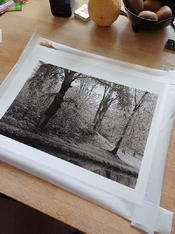brian steinberger
Subscriber
I am personally really pleased with the results I get from the dual bath bleach/redevelop toners, although obviously the extra bath and required washing stage is a significant burden, compensated by the odorlesness.
What is it you feel the polysulphide toners add?
With the bleach/redevelop toners I never felt the need to print darker, but this may be personal preference.
Marco we are still talking about bleach/redevelop sepia toning. It’s just the toning bath is made with sodium sulfide instead of thio/sodium hydroxide. The result is not variable as it is with thio but I’ve heard many say, Cliveh included, that the results produced are superior. The archivability should be the same as thio (atleast that is my understanding.)
Polysulfide toners, also known as brown toners (Viradon R.I.P) are direct toners and produce fantastic results too, but the subject of another thread. I should add that polysulfide toners can be used indirect as well.











